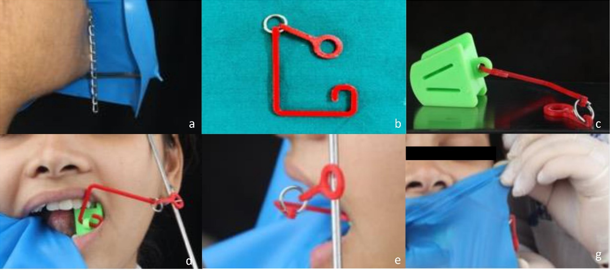- Visibility 17 Views
- Downloads 2 Downloads
- DOI 10.18231/j.aprd.2025.020
-
CrossMark
- Citation
A novel technique to stabilize the bite-block with the rubber dam frame using a connector
Introduction
Rubber dam isolation provides improved access, and visibility and acts like a physical barrier between the selected operator field and the oral cavity, which prevents saliva, blood, gingival crevicular fluid, humid exhaled air, and other debris from interfering with the restorative treatment.[1], [2], [3]
The problem arises when the rubber dam is applied for a long duration, for procedures such as single visit endodontic therapy, broken instrument retrieval or fibre post placement, etc. The TMJ is predominantly vulnerable to stress when the mouth is held open for extended periods. [4] Prolonged dental treatments can undeniably strain the temporomandibular joint (TMJ) and the masticatory muscles.[5] Another study states that prolonged jaw opening can lead to activation and prolonged sensitization of trigeminal neurons that results in nociceptive behaviour evoked by stimulation of the masseter muscle causing temporomandibular disorders.[6]
This treatment-induced trauma to TMJ can be avoided by using a bite-block. It is a device that allows a patient to rest his/her teeth during long treatment procedures. Since the application of a rubber dam covers the entire mouth, the stability of the bite block cannot be guaranteed. Especially when the patient has a sudden coughing episode or gag reflex due to the inadvertent ingestion of irrigating solution in the throat. In such a situation, there is a chance of accidentally slipping or sliding the bite block down the throat hence might cause serious complications.[4] Bite blocks are readily available in the market in different sizes and designs. The currently available bite-blocks that come with a pre-attached chain have some problems.[7] First in case of accidental swallowing of the bite block, the chain attached is not long enough to be pulled out immediately ([Figure 1]). Secondly, after the placement of the rubber dam, this short-length chain is not at all visible, hence the unforeseen displacement of bite-block can’t be ascertained ([Figure 1]a).
This present article describes a technique that involves the use of an innovative connector by which the bite-block can be easily and adequately stabilized with the help of the rubber dam frame which not only eliminates the possibilities of the above-mentioned complications but also gives freedom to the operator to work for longer hours.

Methods
Designing & developing the ‘Innovative Connector’
The problem of safely securing the bite block can be solved if the bite block can be connected or tied to the frame of the rubber dam. Since there are no such connectors available in the market, the authors decided to make a self-designed innovative connector. This connector consists of two arms joined by a ring ([Figure 1]b). The longer arm gets connected with the bite-block with the help of the hook present at the end, and the smaller arm connects with the spike of the rubber dam frame ([Figure 1]c) The connector holds the bite-block in place even during long dental procedures without the fear of displacement. It ultimately provides comfort to the patient and a sense of safety and security to the operator.
Clinical application
After selecting the rubber dam sheet, the clamp and a bite block according to the size of the patient’s mouth, the rubber dam can be applied to the concerned tooth by any preferred method of the operator. Once the entire assembly of the rubber dam is secured onto the tooth. Take a commercially available bite block according to the size of the patient’s mouth. Ask the patient to open the mouth wide, or in case the patient has been anaesthetized, pull down the jaw. Slide the bite block towards the back of the patient’s mouth on the non-working side. Adjust the bite block such that it lies between the maxillary and mandibular molar.
Once the bite block is placed properly, the “innovative connector” can be connected to the slot already present in the bite block with the help of the hook at the end of the longer arm of the connector ([Figure 1]d). The other end; the smaller arm, which has a circle at the end, is tucked onto any of the spikes present on the rubber dam frame ([Figure 1]e). After the innovative connector is attached to the rubber dam and bite block from both ends, the rubber sheet is stretched on the frame to secure the assembly in its place ([Figure 1]g).
Limitations
This connector assembly can be cumbersome in patients suffering from trismus.
Conclusion
The present novel technique, which involves the use of an innovative J-shaped connector, provides a perfect solution to stabilize the bite block without causing any harm to the surrounding hard and soft tissues.
Informed Consent
Consent was obtained from all subjects involved in the study.
Source of Funding
None.
Conflict of Interest
The authors declared no potential conflicts of interest concerning the research, authorship, and/or publication of this article.
References
- C Miao, X Yang, MC Wong, J Zou, X Zhou, C Li. Rubber dam isolation for restorative treatment in dental patients. Cochrane Database Syst Rev 2021. [Google Scholar] [Crossref]
- A Nasser. Rubber Dam Isolation - When and Why to Use it? Part 1. BDJ Student 2021. [Google Scholar]
- S Patel, S Hamer. A simple guide to using dental dam. Br Dent J 2021. [Google Scholar]
- A Lofters, E Clarkson. Mouth Gags: Advantages and Disadvantages. Oral Maxillofac Surg Clin North Am 2021. [Google Scholar]
- S Sahebi, F Moazami, M Afsa, MR Nabavi Zade. Effect of lengthy root canal therapy sessions on temporomandibular joint and masticatory muscles. J Dent Res Dent Clin Dent Prospects 2010. [Google Scholar]
- JL Hawkins, PL Durham. Prolonged Jaw Opening Promotes Nociception and Enhanced Cytokine Expression. J Oral Facial Pain Headache 2016. [Google Scholar]
- S Jelacic, A Bowdle, SK Madhavaram, BB Garana. Design and Evaluation of Novel Bite Block for Invasive Imaging Procedures. A A Pract 2022. [Google Scholar] [Crossref]
